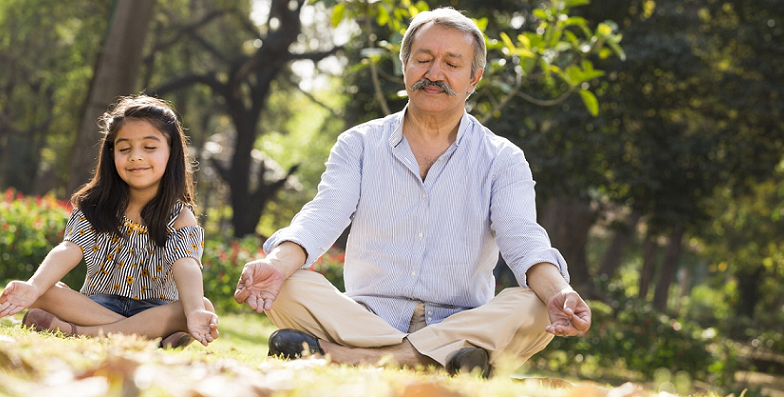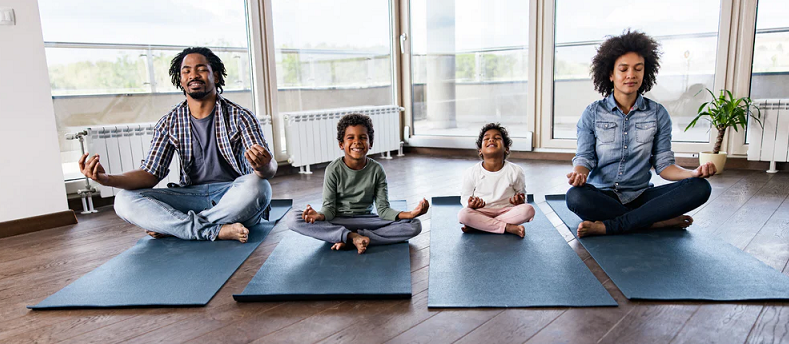
Practicing yoga is an excellent way to improve physical, mental, and emotional wellbeing. When it comes to practicing yoga as a family, the benefits multiply. Yoga can provide a unique opportunity for families to bond, connect, and support each other’s wellness journey. Here we explore the various benefits of practicing yoga as a family and provide some tips to get started.
Yoga and Its Benefits
Yoga is a practice that originated in ancient India and has been gaining popularity worldwide. It involves a combination of physical postures, breathing exercises, and meditation to improve physical, mental, and emotional wellbeing. The practice of yoga can help reduce stress, anxiety, and depression while increasing flexibility, strength, and balance. It also helps to improve focus, concentration, and self-awareness, making it a great tool for personal development.
The benefits of yoga extend beyond the individual practitioner, as it can also bring people together and strengthen relationships. By practicing yoga as a group, whether with friends, coworkers, or family, individuals can experience a sense of community and shared experience.
Yoga can provide an opportunity for people to support each other in their wellness journeys and create a positive, supportive environment. Overall, yoga is a practice that offers numerous benefits to individuals and communities alike, making it a valuable tool for improving overall health and wellbeing.
Physical Benefits of Family Yoga
Family yoga offers a variety of physical benefits to all participants, regardless of age or experience level. Yoga postures, or asanas, are designed to stretch and strengthen different parts of the body.
Practicing yoga regularly can help increase flexibility, balance, and coordination. Many yoga postures require the use of core muscles, leading to improved posture and reduced risk of injury. The practice of yoga can also lead to an increased awareness of the body, which can help individuals identify areas of tension or discomfort and address them appropriately.
Family yoga can be particularly beneficial for children, as it can help promote physical activity and healthy habits from a young age. By participating in family yoga, children can develop their physical skills and improve their overall fitness levels. It can help them develop an appreciation for movement and exercise, setting the stage for a lifetime of healthy habits.
For older adults, practicing yoga can help alleviate common aches and pains, particularly in the back, neck, and shoulders. The gentle movements of yoga can also help improve joint health and flexibility, making it an ideal form of exercise for individuals with limited mobility. The physical benefits of family yoga are numerous and can help individuals of all ages and abilities improve their overall health and wellbeing.

Mental Benefits of Family Yoga
Family yoga can offer a variety of mental health benefits to all participants, including children and adults. The practice of yoga is known to reduce stress and anxiety by encouraging individuals to focus on their breath and their body in the present moment. This can be particularly helpful for children, who may struggle with anxiety or have difficulty regulating their emotions.
The mindfulness aspects of yoga can also improve focus and concentration, making it an ideal practice for individuals of all ages who need to improve their cognitive skills.
Practicing yoga can also promote feelings of positivity and self-confidence. This can be particularly important for children, who may struggle with self-esteem or negative self-talk. Through the practice of yoga, individuals can learn to appreciate their bodies and their abilities, fostering a sense of self-love and self-acceptance.
The practice of yoga can bring people together and create a sense of community and shared experience. By participating in family yoga, individuals can strengthen their relationships and feel supported by those around them. Overall, the mental benefits of family yoga are numerous and can help individuals of all ages and abilities improve their overall health and wellbeing.

Emotional Benefits of Family Yoga
Family yoga can provide numerous emotional benefits to all participants, including children and adults. The practice of yoga involves a combination of physical movement and mindfulness, which can help individuals connect with their bodies and emotions.
Practicing yoga as a family can create a sense of togetherness and belonging, which can promote feelings of happiness and contentment. This can be particularly important for children, who may struggle with feelings of isolation or loneliness.
Along with promoting positive emotions, family yoga can also help individuals develop communication and listening skills. During family yoga practice, individuals are encouraged to work together and support each other in their movements. This can create a sense of trust and empathy, which can translate into improved communication skills in other areas of life. Family yoga can also help individuals develop problem-solving skills, as they learn to work together to find solutions to movement challenges.
Family yoga can help individuals develop a sense of gratitude and appreciation for their bodies and their relationships. By practicing yoga as a family, individuals can learn to appreciate their bodies and abilities, fostering a sense of self-love and acceptance. This can also translate into improved relationships with others, as individuals learn to appreciate the unique qualities of those around them.

Tips for Practicing Yoga as a Family
Practicing yoga as a family can be a wonderful way to bond and promote overall wellness. However, it can also present unique challenges, particularly if family members have different levels of experience or abilities. To make family yoga practice successful and enjoyable, it is important to keep a few tips in mind.
First, it is important to choose the right time and place for practice. Ideally, this should be a quiet and calm space with minimal distractions. It can also be helpful to choose a time when everyone is well-rested and not too hungry.
When practicing yoga as a family, it is also important to choose poses that are appropriate for everyone. This may mean modifying poses or choosing variations that are accessible to all. It can also be helpful to encourage family members to listen to their bodies and take breaks as needed.
It is important to be mindful of each family member’s limitations and abilities. For example, children may not be able to hold a pose as long as adults or may have difficulty with certain movements. Being patient and supportive can help make the practice more enjoyable for everyone.
It can also be helpful to create a sense of fun and playfulness during family yoga practice. This can be done by incorporating music, encouraging creative expression, or practicing partner poses. By making family yoga practice engaging and enjoyable, individuals are more likely to stick with it and reap the many benefits of the practice.
